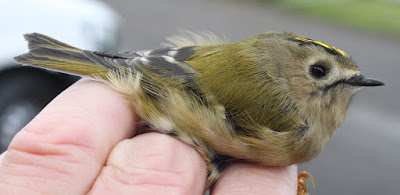The last ringing session at Oakenclough 8th October 2016 gave us 63 Goldcrests out of a total of 121 birds caught. I met Andy at 0715 this morning and while we were far from sure quite what to expect, we didn’t imagine Goldcrests would dominate the field sheet again.
The ringing was steady if unspectacular whereby at midday when we left the total of birds caught stood at 53 with Goldcrests providing more than 50% again.
Totals today: 27 Goldcrest, 10 Greenfinch, 4 Lesser Redpoll, 2 Chaffinch, 2 Blackbird, 2 Treecreeper, 1 Goldfinch, 1 Redwing, 1 Song Thrush, 1 Blue Tit, 1 Coal Tit, 1 Dunnock.
Lesser Redpoll
Treereeper
There was quite a movement of Greenfinch this morning with small groups of 10-15 birds arriving and approximately 60+ throughput the morning. At one point a flock of 20+ left to the north with a flock of Fieldfares. We caught zero Fieldfares today out of approximately 100+ which arrived unseen from the south and fed on berries for a short while before leaving to the north. Redwings were in short supply with less than twenty seen throughout our stay and just the one caught.
Greenfinch
Redwing
One of the two Blackbirds was of the “continental” type with a very dark bill and scalloped breast feathers.
"Continental" Blackbird
Goldcrest
The Goldcrest has a large range, estimated at 13.2 million square kms with a total population of 80–200 million individuals. (Wiki) There has been some northward range expansion in Scotland, Belgium, Norway, Finland and even Iceland during the 20th century, assisted by the spread of conifer plantations. A female lays 10-12 eggs and second broods are common. After a successful summer the population can increase many times over and a huge number of those birds looking to migrate south to escape the winters of much of their breeding range. The population is currently thought to be stable although there may be temporary marked declines in harsh winters of normally temperate Western Europe where the Goldcrest winters.
As in our previous Goldcrest catch of 8th October we noticed today that most had good weights of slightly above the expected norm of 5 to 5.5gms with many approaching 6gms. Looking more closely today a number of our birds also showed a larger amount of grey around the head than a typical UK bird. These greyish headed Goldcrests are thought to be possibly from one or two of the eastern forms of the Goldcrest (see below). Alternatively, given such a widespread, numerous and highly migratory species there are likely to be intergrades of types.
In continental Eurasia there are nine generally accepted and very similar subspecies of Goldcrest Regulus regulus which differ only in details such as plumage shade:
- R. r. regulus. Breeds in most of Europe; this is the nominate subspecies and the one resident in the UK.
- R. r. japonensis. Breeds in Eastern Asia, including Japan, Korea, China and Siberia; it is greener and has darker upper-parts than the nominate form, and has broad white wingbars.
- R. r. coatsi. Breeds in Russia and Central Asia, and is paler above than the nominate subspecies.
- R. r. tristis . Breeds in China and Central Asia, wintering in northeastern Afghanistan. It is distinctive, with the black edges to the crest largely absent. The crown of the male is yellower than in other forms, and the underparts are much duller and greyer.
- R. r. himalayensis. Breeds in the Himalayas; it is similar to the nominate subspecies, but slightly paler above and with whiter underparts.
- R. r. yunnanensis . Breeds in the Eastern Himalayas, Burma and China; it is like R. r. sikkimensis, but darker overall with dark green upper-parts and darker buff underparts.
- R. r. hyrcanus. Breeds only in Iran; it is like R. r. buturlini, but slightly darker.
- R. r. buturlini. Breeds in Eastern Europe, the Caucasus and Central Asia. It is paler above than the nominate subspecies, and greyish-green rather than olive.
- R. r. sikkimensis. Breeds in India and China. It is darker than R. r. himalayensis, and greener than the nominate subspecies.
It all makes for much thought and closer investigation of birds in the hand when time and available hands allow. The priority always is to ring, process and release a bird as quickly as possible, especially where small and vulnerable birds like Goldcrests are concerned.
Other birds seen/heard this morning: 2+ Brambling, 3 Grey Wagtail, 2 Pied Wagtail, 1 Sparrowhawk, 1 + Bullfinch.
Linking today to Eileen's Saturday.
Linking today to Eileen's Saturday.








































































